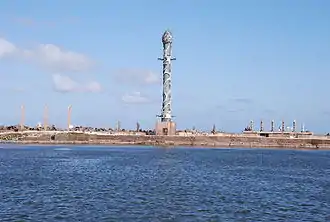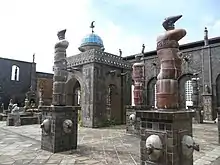Francisco Brennand
Francisco Brennand, or Francisco de Paula de Almeida Brennand, (June 11, 1927 – December 19, 2019), was a Brazilian painter and sculptor, best known for his work in ceramics.
Francisco Brennand | |
|---|---|
 | |
| Born | June 11, 1927 |
| Died | December 19, 2019 (aged 92) Recife |
| Nationality | Brazilian |
| Occupation | Sculptor and visual artist |
Life
Francisco de Paula de Almeida Brennand was born in Recife, Brazil, to Ricardo Monteiro Brennand and Olímpia Padilha Nunes Coimbra on June 11 1927. He was a descended from an Irish ancestor who migrated to Recife in 1820 and married into a sugar plantation family. His father, Ricardo Brennand, added ceramic tile and brick to the business in 1917, and sent his son Francisco to Europe to study technical ceramic skills. Arriving in Paris in 1949, Brennand discovered the ceramic work of Pable Picasso, Joan Miró and Fernand Léger, and become a ceramic artist.[1]
In 1948, he married Déborah de Moura Vasconcelos.[2]
In 1971, Brennand returned to the ruins of his father's tile factory and set about turning it into what would become the Oficina Brennand, producing both tiles and his own ceramic sculpture.[2]
Brennand died of a respiratory infection on December 19, 2019, at the Real Hospital Português in Recife, at the age of 92.[2] The Governor of the state of Pernambuco declared a three-day period of mourning.[2]
Work

Brennand primarily displayed his work at the Oficina Brennand, the compound encompassing the working tile factory, museum, chapel, and café. The Oficina features around 2,000 of Brennand's pieces in enormous open halls, outdoor monuments, alters, chapels, and gardens, all in the midst of an Atlantic forest reserve in the Varzea neighborhood of Recife. His work often returns to themes of the human body, eggs, animals, and fruit. At times, he was forced to defend his work against charges that it was too provocative or erotic.[3][1] The New York Times called Brennand "the foremost artist in the city" and the Oficina Brennand "a metaphor for the city of Recife itself, consumed in simultaneous growth and decay."[4] He has also been called "Brazil's greatest ceramicist."[5]
More than 90 of his works, including the 32-meter Crystal Tower, can be seen at the Parque das esculturas (Sculptures Park), located in the Recife Antigo port district in Recife. The city commissioned this park in 2000 in celebration of the 500th anniversary of the arrival of Europeans in Brazil.[6]

Exhibits
- Propriedade Santos Cosme e Damião, Várzea (the artist's studio)
- Marco Zero square in Recife Antigo, Recife (the Sculpture Park)
- 18th São Paulo Art Biennial – 1985[6]
- 20th São Paulo Art Biennial – 1989
- Esculturas 1974–1998 at the Pinacoteca do Estado de São Paulo – 1998[7]
- Casa França-Brasil, Rio de Janeiro – 2000
- Esculturas at the Oscar Niemeyer Museum, Curitiba – 2004
References
- Rohter, Larry (April 22, 2004). "In Brazil, Iconoclast Is Bearded In His Den; A Controversial Sculptor Revels in His Menagerie". The New York Times. ISSN 0362-4331. Retrieved December 20, 2019.
- "Francisco Brennand, ceramista e artista plástico, morre aos 92 anos no Recife". G1 (in Portuguese). Retrieved December 19, 2019.
- Rohter, Larry (November 25, 2000). "Brazilians Dazzled (Mostly) By Prospect of a Guggenheim". The New York Times. ISSN 0362-4331. Retrieved December 20, 2019.
- Miller, Susan Katz (September 3, 1995). "Bustle and Beaches in Brazil's North". The New York Times. ISSN 0362-4331. Retrieved December 20, 2019.
- "Oficina Cerâmica Francisco Brennand | Recife, Brazil Attractions". www.lonelyplanet.com. Retrieved December 20, 2019.
- http://www.artfacts.net/en/artist/francisco-brennand-51224/profile.html
- "Archived copy". Archived from the original on September 5, 2009. Retrieved August 9, 2009.CS1 maint: archived copy as title (link)
External links
- (in Portuguese) Brennand's official homepage
- (in Portuguese) Brennand's diary extracts
- Photographs of Oficina Brennand by Jonathan Flaum